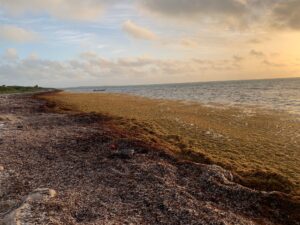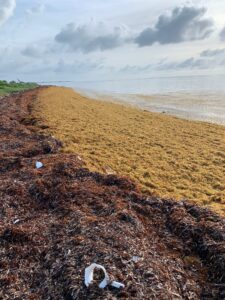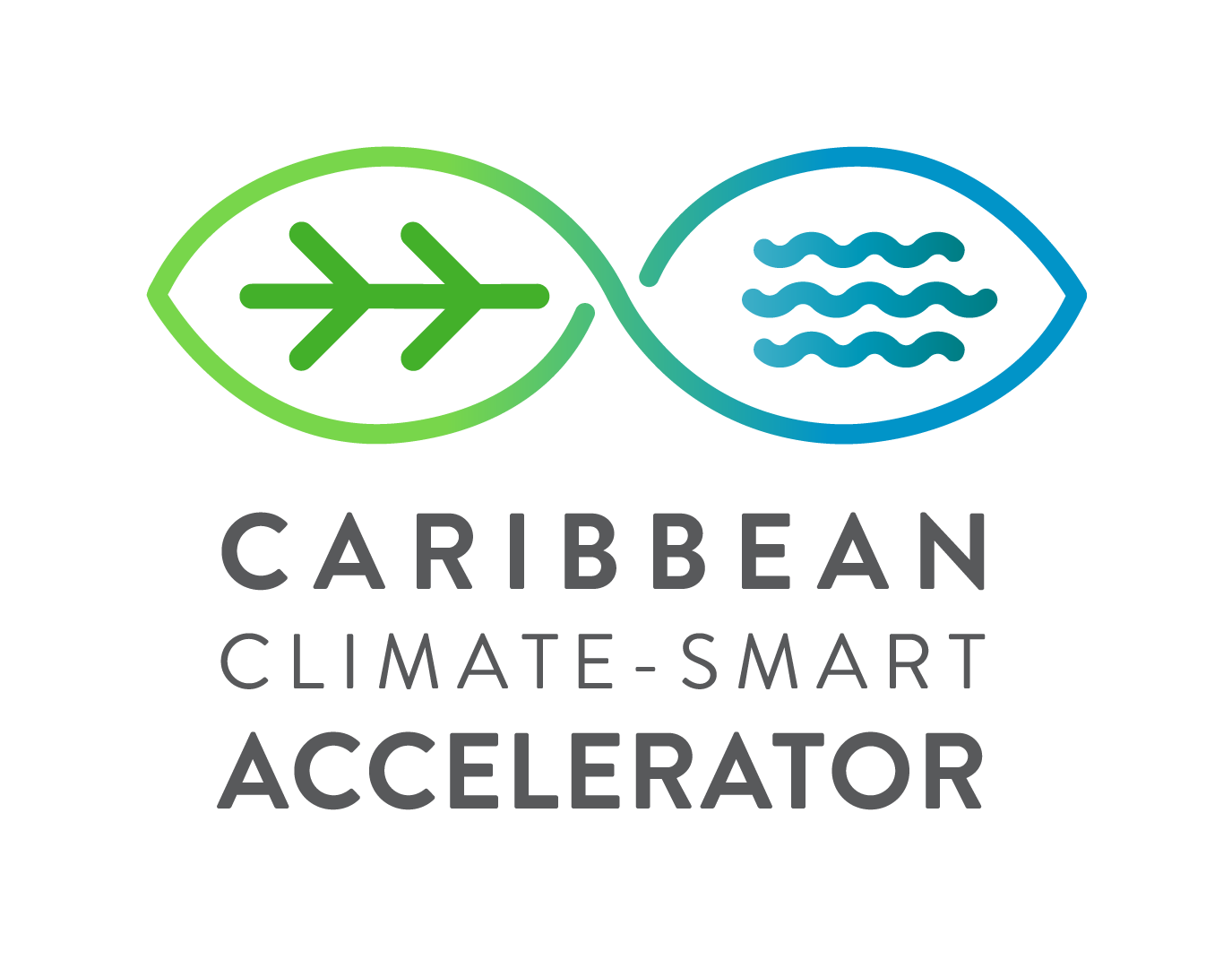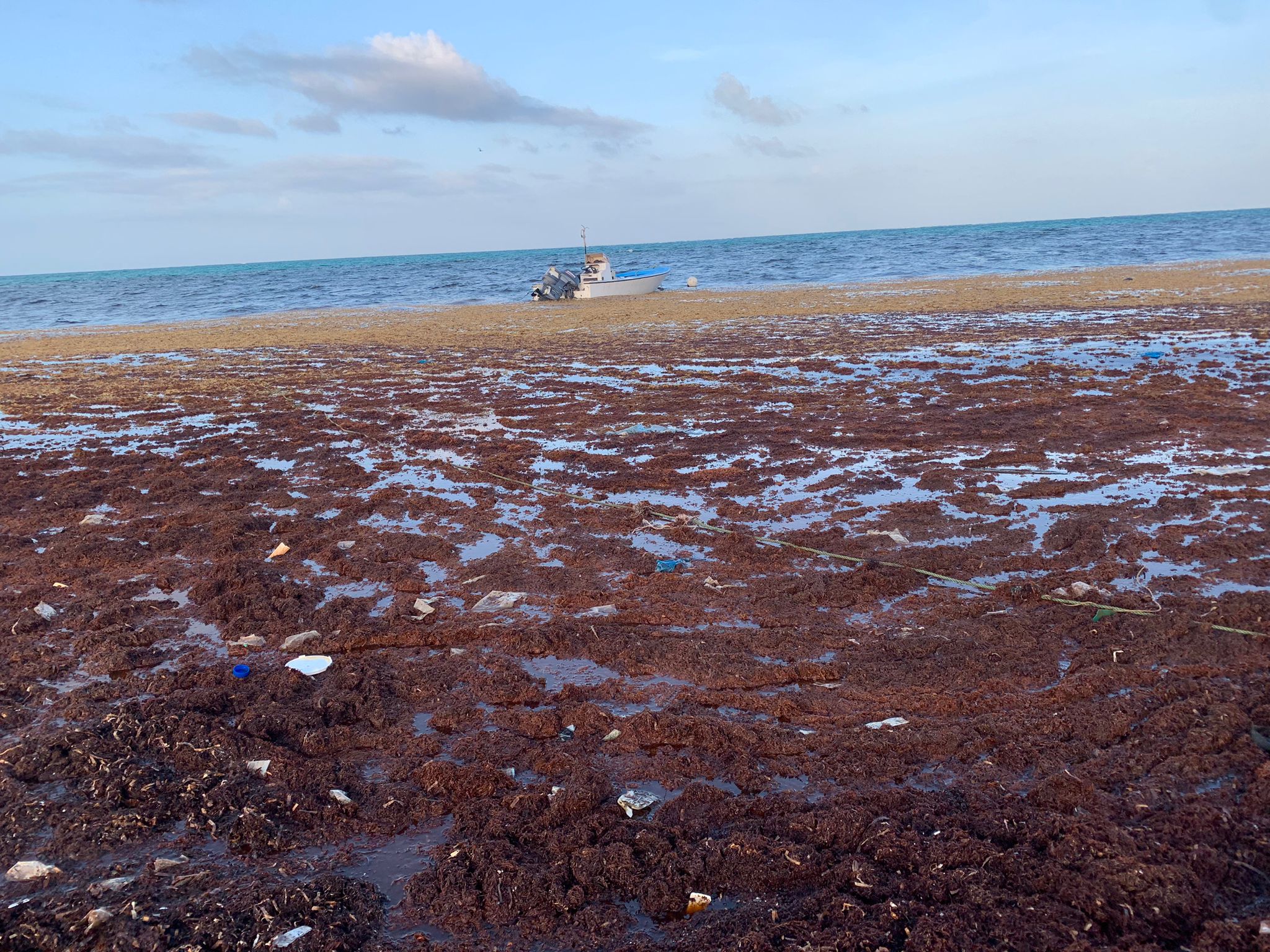Sargassum, a common Caribbean climate problem
Elvira Hernández, Gladstone Taylor, Deandre Williamson
Caribbean Climate Justice Journalism Fellows

Sargassum seaweed piles up on the beach in Pinefield, Acklins, Bahamas during its peak in 2022. (Photos/Rev. Philip Williamson)
For many throughout the Caribbean, sargassum is stinky, yucky and nasty, and destroys the natural beauty of beaches. As annual sargassum blooms grow, their effects on Caribbean countries such as Jamaica, The Bahamas and the Dominican Republic go beyond the usual tourist nuisance.
The disproportionate increase of this algae is beginning to affect coastal life in general, from fishermen to visitors. The main problem of sargassum is the decomposition process that generates an unbearable odor.
Indeed, excess sargassum is one of the effects of climate change and adds to the urgent need for climate justice for the Caribbean.
“It makes the water muddy and yucky, so fish go further out,” Rev. Philip Williamson, a fisherman and resident in Acklins, Bahamas, said as he gave an account of the impact sargassum has on his community.
As a young boy, he remembers playing on the beach during the summers with his cousin near their home in Pinefield, Acklins. But now, as an adult, he can’t enjoy the same beach during the summers because of the vast amount of sargassum lying on the shoreline, which creates a stink scent in the settlement.
“It’s tough on us sometimes,” Rev. Williamson said. “Sometimes we have to close the east window because it comes straight into your room. In the night time when you’re trying to sleep, you can smell it so you have to close the window down.”
When sargassum washes up on the shore, it starts to rot as it emits hydrogen sulfide, a gas that smells like rotten eggs. Rotting sargassum can cause health problems like eye, nose and throat irritation because of the hydrogen sulfide.
The sargassum on the beach opposite Rev. Williamson’s home in Pinefield, Acklins builds up during its peak, causing dead fish to get trapped in the seaweed which adds to the unpleasant odor.
In some Caribbean countries, sargassum begins to wash up on the shore in June and continues until around October.
According to the University of South Florida, the sargassum bloom is expected to increase in size this year and a mass of the seaweed is already floating toward the West Coast of Florida in the Gulf of Mexico and will likely be the largest ever recorded.
Sargassum threatens tourism
Jamaica, The Bahamas and the Dominican Republic are sought-after tourist destinations in the Caribbean and tourism is a major industry for these Small Island Developing States (SIDS). Unfortunately, sargassum can threaten this industry.
According to UNESCO, “The number of reports of these events in previously unaffected areas has increased worldwide in recent years. Nutrients overloads from agricultural runoff and wastewater discharge, rising of sea temperature and the change of sea currents induced by climate change are all factors that are believed to contribute to the breakout of these events.”
In the Dominican Republic, the massive invasion of sargassum adds to one of the many climate challenges. The year 2022 registered important figures of the accumulation of this macroalgae in the Caribbean. In this regard, the National Authority of Maritime Affairs (ANAMAR) estimated that “around four million tons of sargassum had invaded the coasts of Punta Cana, Guyacanes, Boca Chica, Barahona, Samaná and Montecristi.” The Dominican Republic’s Vice Minister of Coastal and Marine Resources of the Ministry of Environment and Natural Resources, José Ramón Reyes, indicated that by 2022, approximately 64,000 tons of sargassum will be registered in the region.
Undoubtedly, this phenomenon impacts tourism-based economies, aquaculture and traditional artisanal fisheries. This is corroborated by Raymundo Méndez and Félix Carrión, Dominican beach workers and members of the Union of Beach, Hotel and Tourism Workers of Guayacanes and Surrounding Areas (SINPLAGHT).
“The economic impact has been strong, 60 percent of the clients have been lost,” said Méndez, who has been working in this place for 22 years as a fisherman and customer service.
Carrión, a 60-year-old man who has dedicated almost all his life to serving this beach, renting chairs, tables and umbrellas, said he saves money to face the critical season from March to September each year.
It is alarming that in just one month of 2023, the Caribbean has been impacted with 15 metric tons of sargassum, Reyes said. He emphasized that sargassum is a threat to the tourist economy, the environmental and health sectors.
The macroalgae causes the erosion of beaches due to the collection of sargassum with sand; the loss of seagrass meadows; the mortality of marine and reef fauna and flora; the accelerated eutrophication of mangroves; the bad appearance, unpleasant odor generated by the rotting of the sargassum, among other disorders, he explained.
Possibility of using sargassum as fertilizer
However, there are some who believe sargassum can be used as fertilizer, especially on islands with poor soil content. Sargassum does in fact provide food and shelter for sea creatures while in the ocean, but the inconvenience of the larger blooms on land are growing due to human impacts. One thing is for certain, while it used to be feasible to leave the smaller amounts of sargassum on the beaches to dry and rot, these growing blooms currently ensure that is no longer the case.
Rev. Williamson believes sargassum is good fertilizer and has an idea for an initiative to remove the seaweed from the beaches throughout Acklins.
“I need like a Bobcat,” Rev. Williamson said. “If we had the means that whereby every day when seaweed comes to the shore, we pick it up before it piles up and bring it on land and dump it, then over the summer accumulate all of that seaweed. In Acklins, we have a lot of quarry pits. Take that same seaweed and put in all those pits. Over time, let the rain wash them and put soil in that. You’ll be amazed what kind of stuff you can grow in that.”
Rev. Williamson further explained that Acklins has poor sandy soil that is not good for farming and suggests that sargassum should be used to enrich the soil.
Others also agree that these large mounds of the seaweed cannot remain on Caribbean beaches, less the impacts compound further. While many business heads and entrepreneurs are jumping at the chance to turn this seaweed into gold, the solution for the annoying pile up may not be as simple.
According to the Jamaica Environment Trust (JET) CEO Dr. Theresa Rodriguez-Moodie, “We know more about the properties of sargassum than we did a few years ago. The fact that it contains a lot of arsenic, salt and other heavy metals means we cannot just pick it up and use it for things like fertilizers or animal fodder.” Exposure to these substances, whether consumed or otherwise could lead to slow, long term effects like metal poisoning.
Still all hope is not lost on the solutions front. Kee Farms, among others, are in the process of patenting unique processes that entail burning the seaweed and turning it into some kind of biofuel. “Once this arsenic is removed however, sargassum has the potential to be used widely,” Dr. Moodie added.
While biofuel solutions have proven difficult to maintain in developing countries like Jamaica, this onslaught of sargassum might solve that maintenance issue. Sargassum is rich in nutrients and substances that can be used to produce fuel, a utility that the modern world is desperately trying to transition into sustainability.
This increase in sargassum bloom could be another key source of organic energy in the fight against fossil fuels. Trade secrets and NDAs prevent the outing of exact details regarding the process, but it is a solution nonetheless. One that could help to mitigate this increasing sargassum issue while the verdict on the science of the heavy metals is still out.
In the Dominican Republic, a team of researchers from the Instituto Tecnológico de Santo Domingo (Intec), together with other institutions, presented the preliminary results of a liquid sargassum biofertilizer for use in agriculture. According to the newspaper El Dinero, the researchers explained: “The application of algae to soils as conditioning agents can improve plant growth, health, and yield by renewing soil texture and moisture retention capacity.”
According to president of the Academy of Sciences, Eleuterio Martínez, sargassum could be also used and processed to make biogas or any other fuel because plants have the ability. He also agrees with the president of the National Authority of Maritime Affairs (ANAMAR), Jimmy García Saviñón, who said sargassum could be used as a source for electrical energy.
Regarding the actions of the Dominican State to alleviate this phenomenon, Reyes and Enrique Pugibet Bobea, vice-minister and advisor of the vice-ministry of Coastal and Marine Resources of MIMARENA, respectively, explained that the institution has a definition of protocols and guidelines for the management of the macroalgae that includes its removal by hand or with special equipment to avoid erosion of the beaches.
In the private sector, the collection of sargassum could generate a source of employment. In Punta Cana, “it would generate more than 500 direct jobs if sanitation systems are developed and implemented by entities trained in the management of the technology or LCM system,” informed the president of SOS Carbon, Andrés Bisonó León, according to El Caribe.
While Dr. Lester Gittens, senior fisheries officer at the Department of Marine Resources in The Bahamas, suggests that more research should be done on the impacts of using sargassum as fertilizer, he believes sargassum should be left alone until the tide takes it back to sea, if it is in an area where it is not affecting human health. Dr. Gittens added that if sargassum is in an area that’s affecting persons, the tourism industry or human health, there are proper ways to remove it, which should be followed.
Additional impacts of sargassum on marine life
However, there are some lesser-known impacts sargassum has on the environment.
Dr. Gittens explained that sargassum could possibly affect turtle nesting. “For example, if the beaches are inundated, then it coincides when turtles will nest, then it will certainly impact turtle nesting,” he said.
Having this massive amount of rotting organic matter sitting in the water can have significant impacts on organisms and marine life.
“If this sargassum comes up to shore and is washed back to sea and starts to rot, that can cause other negative impacts in the marine environment that can for example, cause significant drop in the oxygen content due to bacterial activity, which could lead to die offs,” Dr. Gittens said.
“By this sargassum being there when it will normally not, that could impact the life cycles of many species of fish in a few days, to a few weeks, to a few months. I know, for example, in the Cayman Islands it is actually speculated that a decline in the bonefish numbers seen there could be due to the sargassum. That’s highly speculatory, but it is a possibility and it would make perfect sense that you could have a decrease in numbers of certain species of fish because of this huge amount of sargassum.”
Sargassum, a matter of climate justice
The Kyoto Protocol of 1992 committed leaders of the world’s developed countries to help balance the scales and the effects of climate change on the globe. Considering the fact that these more developed countries and their large corporations tend to produce and release way more greenhouse gasses than Small Island Developing States (SIDS), it is only fair and just.
Although these increasing sargassum blooms are the result of many factors compounded into one, climate change is a defining factor. From the acidification of the ocean, to its warming and even the more erratic weather and winds affecting currents that carry these massive blobs of the algae into waters surrounding the Caribbean. It’s clear that this sargassum issue is largely a reality because of the climate crisis. The responsibility of assistance falls squarely in the laps of the main contributors to this crisis who ironically are more equipped to recover from them.

Sargassum seaweed piles up on the beach in Pinefield, Acklins, Bahamas during its peak in 2022. (Photos/Rev. Philip Williamson)
The sargassum issue will not be going away and therefore the importance of building resilience and recovery ability is essential for countries like Jamaica, The Bahamas and Dominican Republic. Solutions are one thing, but as the influx of sargassum continues to grow, how it affects the ecosystem may also begin to change and intensify. Being able to effectively pull these algae from waters and beaches, in a way that is considerate of the environment is essential. It would be unfortunate to go onto a beach with the desire to remove the sargassum but end up disrupting the entire ecosystem of that beach and possibly harming marine life there. This sargassum phenomenon is still a concern and so few policies from the governments exist to curtail it, however that may change following the upcoming COP28.
This story was published with the support of the Caribbean Climate Justice Journalism Fellowship, which is a joint venture of Climate Tracker and Open Society Foundations.
About the Fellowship
The Caribbean Climate Justice Journalism Fellowship is offered by Climate Tracker, an international non-profit organization, aiming to support, train and incentivize better climate journalism globally. The fellowship provides a platform for journalists to learn and publish stories about the search for solutions that deal with the core causes of climate change while addressing a wide range of social, racial, and environmental injustices that exist. Over the course of six months, fellows will learn from a range of environmental, storytelling, and journalism experts, while practically applying their learning in articles aimed at sharing the national and regional climate justice debates, with the primary intention and focus on publishing powerful stories on climate justice. This fellowship will take a holistic and career-building perspective that actively integrates fellows into the building of a fruitful community for Caribbean climate journalists, storytellers, and communicators.






